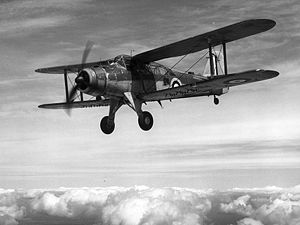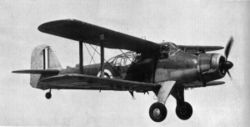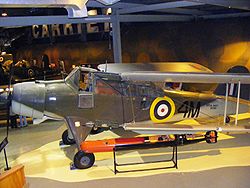Fairey Albacore Video - Picture

|
|
Fairey Albacore
Albacore

Picture - L7075, the second prototype of the Fairey Albacore in flight. The markings place it around 1940.
Role: Torpedo Bomber
Manufacturer: Fairey Aviation
Designed by: Marcel Lobelle
First flight: 1938
Introduced: 1940
Retired: 1944
Primary users: Royal Navy
Royal Air Force
Royal Canadian Air Force
Number built: 800
The Fairey Albacore was a British single-engine carrier-borne biplane torpedo bomber built by Fairey Aviation between 1939 and 1943 for the Fleet Air Arm and used during the Second World War. It had a three-man crew and was designed for spotting and reconnaissance as well as delivering bombs and torpedoes. The Albacore, popularly known as the "Applecore", was conceived as a replacement for the aging Fairey Swordfish, which had entered service in 1936. However, the Albacore served with the Swordfish and was retired before it, being replaced by the Fairey Barracuda and Grumman Avenger monoplane torpedo bombers.
Design and development
The Albacore prototypes were built to meet Specification S.41/36 for a three-seat TSR (torpedo/spotter/reconnaissance) for the FAA to replace the Swordfish. Like the Swordfish, the Albacore was fully capable of dive bombing: "The Albacore was designed for diving at speeds up to 215 knots(400 km/h) lAS with flaps either up or down, and it was certainly steady in a dive, recovery being easy and smooth..." and the maximum under wing bomb load was 4 x 500lb bombs. The Albacore had a more powerful engine than the Swordfish and was more aerodynamically refined. It offered the crew an enclosed and heated cockpit. The Albacore also had features such as an automatic liferaft ejection system which triggered in the event of the aircraft ditching. The first of two prototypes flew on 12 December 1938 and production of the first batch of 98 aircraft began in 1939. Early Albacores were fitted with the Bristol Taurus II engine and those built later received the more powerful Taurus XII. Boscombe Down testing of the Albacore and Taurus II engine, in February 1940, showed a maximum speed of 160 mph (258 km/h), at an altitude of 4,800 ft (1,463 m), at 11,570 lb (5,259 kg), which was achieved with four under-wing depth charges, while maximum speed without the depth charges was 172 mph (277 km/h). An Albacore fitted with the Taurus II engine and carrying a torpedo weighed 11,100 lb (5,045 kg).
A total of 800 Albacores were built.
Operational history

Picture - Fairey Albacore N4389, 827 Naval Air Squadron, HMS Victorious. Shot down during raid on Kirkenes, July 1941. Salvaged, rebuilt and now on display in the FAA Museum
No. 826 Naval Air Squadron was specially formed to operate the first Albacores in March 1940 , being used for attacks against harbours and shipping in the English Channel, operating from shore bases, and for convoy escort for the rest of 1940. Formidable's 826 and 829 Squadrons were the first to operate the Albacore from a carrier, with operations starting in November 1940. Initially, the Albacore suffered from reliability problems with the Taurus engine, although these were later solved, so that the failure rate was no worse than the Pegasus that equipped the Swordfish . It remained less popular than the Swordfish, however, as it was less agile, with the controls being too heavy for a pilot to take effective evasive action after dropping a torpedo .

Picture - Albacore in flight. The markings place it around 1940.
Eventually, there were 15 first-line FAA squadrons equipped with the Albacore which operated widely in the Mediterranean. Albacores played a prominent role in the ill-fated raid on Kirkenes and Petsamo in July 1941. More successfully they participated in the Battle of Cape Matapan and the fighting at El Alamein as well as supporting the landings at Sicily and Salerno. During the period September 1941 to end of June 1943, No. 828 Sqn. FAA, RAF Hal Far, Malta, operated a squadron of Albacores under some of the most severe blitz conditions imaginable during the siege of Malta, mainly against Italian shipping and shore targets in Sicily.
On 9 March 1942, 12 Albacores from HMS Victorious were launched to attack the battleship German battleship Tirpitz at sea near Narvik. Based on information from one of six radar equipped aircraft already launched, Albacores from 817 and 832 squadrons launched torpedoes and some also attacked with their machine guns. A courageous attack came within 30 ft of success at the bow but ultimately the FAA's only torpedo attack on the Tirpitz at sea failed with the loss of two aircraft and damage to many of the others.
In 1943, the Albacore was progressively replaced in Fleet Air Arm service by the Barracuda. The last FAA Albacore squadron, No. 841 Sqn. FAA, (which had been used for shore based attacks against shipping in the Channel for the whole of its career with the Albacore) , disbanded in late 1943.
The Royal Air Force deployed some Albacores; No. 36 Sqn. acquired them in December 1941 when in Java. The squadron was captured by the Japanese in March 1942. In 1943, No. 415 Sqn. was equipped with Albacores (presumably ex-FAA) before the Flight operating them was transferred and reformed as No. 119 Sqn. at RAF Manston in July 1944. The squadron deployed later to Belgian airfields. Their Albacores were disposed of in early 1945 in favour of ASV-radar equipped Swordfish Mk.IIIs that the squadron kept until the end of the war in May.
The Royal Canadian Air Force took over the Albacores and used them during the Normandy invasion, for a similar role until July 1944.
Operators
Canada
Royal Canadian Air Force
No. 415 Squadron RCAF
United Kingdom
Royal Air Force
No. 36 Squadron RAF
No. 119 Squadron RAF
Royal Navy Fleet Air Arm
700 Naval Air Squadron
733 Naval Air Squadron
747 Naval Air Squadron
750 Naval Air Squadron
753 Naval Air Squadron
754 Naval Air Squadron
756 Naval Air Squadron
763 Naval Air Squadron
766 Naval Air Squadron
767 Naval Air Squadron
768 Naval Air Squadron
769 Naval Air Squadron
771 Naval Air Squadron
774 Naval Air Squadron
775 Naval Air Squadron
778 Naval Air Squadron
781 Naval Air Squadron
782 Naval Air Squadron
783 Naval Air Squadron
785 Naval Air Squadron
786 Naval Air Squadron
787 Naval Air Squadron
788 Naval Air Squadron
789 Naval Air Squadron
791 Naval Air Squadron
793 Naval Air Squadron
796 Naval Air Squadron
797 Naval Air Squadron
799 Naval Air Squadron
810 Naval Air Squadron
815 Naval Air Squadron
817 Naval Air Squadron
818 Naval Air Squadron
820 Naval Air Squadron
821 Naval Air Squadron
822 Naval Air Squadron
823 Naval Air Squadron
826 Naval Air Squadron
827 Naval Air Squadron
828 Naval Air Squadron
829 Naval Air Squadron
830 Naval Air Squadron
831 Naval Air Squadron
832 Naval Air Squadron
841 Naval Air Squadron
Surviving Aircraft

Picture - Albacore (N4389) at the Fleet Air Arm Museum
Only one Albacore is known to exist, it is displayed at the Fleet Air Arm Museum. It was built using parts of Albacores N4389 and N4172, that were both recovered from crash sites.
Specifications (Albacore)
Data from The British Bomber since 1914
General characteristics
Crew: Three
Length: 39 ft 10 in (12.14 m)
Wingspan: 50 ft 0 in (15.24 m)
Height: 14 ft 2 in (4.62 m)
Wing area: 623 ft² (57.9 m²)
Empty weight: 7,250 lb (3,295 kg)
Loaded weight: 10,460 lb (4,755 kg)
Max takeoff weight: 12,600 lb (5,727 kg)
Powerplant: 1x— Bristol Taurus II (Taurus XII) 14-cylinder radial engine, 1,065 hp (1,130 hp) (794 kW (840 kw))
Performance
Maximum speed: 140 kn (161 mph, 259 km/h)
Cruise speed: 122 kn (140 mph, 225 km/h) (maximum cruise)
Stall speed: 47 kn (54 mph, 87 km/h) (flaps down)
Range: 817 nmi (930 mi, 1,497 km) (with torpedo)
Service ceiling: 20,700 ft (6,310 m)
Climb to 6000 ft 8 min
Armament
Guns:
1 x— fixed, forward-firing .303 in (7.7 mm) machine gun in starboard wing
1 or 2 x— .303 in (7.7 mm) Vickers K machine guns in rear cockpit.
Bombs: 1 x— 1,670 lb (760 kg) torpedo or 2,000 lb (907 kg) bombs
Related development
Fairey Swordfish
Comparable aircraft
Fieseler Fi 167
Nakajima B5N
TBD Devastator
Bibliography
Brown, Eric, CBE, DCS, AFC, RN., William Green and Gordon Swanborough. "Fairey Albacore." Wings of the Navy, Flying Allied Carrier Aircraft of World War Two. London: Jane's Publishing Company Ltd, 1980, pp. 60-69. ISBN 0-7106-0002-X.
Harrison, W.A. Fairey Albacore (Warpaint Series No. 52). Luton, Bedfordshire, UK: Warpaint Books Ltd., 2004.
Harrison, W.A. Fairey Swordfish and Albacore. Wiltshire, UK: The Crowood Press, 2002. ISBN 1-86126-512-3.
Jefford, Wing Commander C.G., MBE, BA, RAF(retd). RAF Squadrons, a Comprehensive Record of the Movement and Equipment of all RAF Squadrons and their Antecedents since 1912. Shrewsbury, Shropshire, UK: Airlife Publishing, 2001. ISBN 1-84037-141-2.
Mason, Francis K. The British Bomber Since 1914. London: Putnam Aeronautical Books, 1994. ISBN 0-85177-861-5.
Mason, Tim. The Secret Years: Flight Testing at Boscombe Down 1939-1945. Manchester, UK: Hikoki, 1998. ISBN 0-95198-999-5.
Shores, Christopher, Brian Cull and Yasuho Izawa. Bloody Shambles: Volume One: The Drift to War to the Fall of Singapore. London: Grub Street, 1992. ISBN 0-948817-50-X.
Taylor, H.A. Fairey Aircraft since 1915. London: Putnam & Company Ltd., 1974. ISBN 0-370-00065-X.
Thetford, Owen. British Naval Aircraft Since 1912 (Fourth Edition). London: Putnam Aeronautical Books, 1994. ISBN 0-85177-861-5.
Fairey Albacore Pictures
More aircraft.
Source: WikiPedia